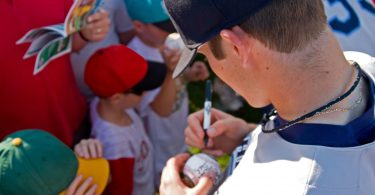The baseball component of getting recruited to play college baseball, at its core, is very simple. Meet or exceed the standard of play for a team/league/division/level and you can play at that level. Come up short on those standards and you have to show the promise or projectability that tells coaches that you are likely to play at or above the standards down the road.
To clarify what we mean by standard of play, we can turn to the dictionary definition of standard:
Standard
noun
- a level of quality or attainment.
“their restaurant offers a high standard of service”
2. an idea or thing used as a measure, norm, or model in comparative evaluations.
“the wages are low by today’s standards”
| synonyms: | quality, level, grade, caliber, merit, excellence
“the standard of her work” |
Both of these definitions are helpful in explaining what we mean by meeting the standard of play. The standard of play for D1 baseball, for example, is the level of quality with which the baseball is played. It is also a great way to compare a player’s skill set to the average skills, which is even more useful when it comes to recruiting. For example, if the standard D1 fastball is 87 miles per hour and Recruit A’s fastball is 82, we can clearly say that it is below the standards of a D1 fastball, and makes it highly unlikely that Recruit A will get recruited by D1 teams, unless he is well above standard in other areas. For recruiting purposes, the more specific you can make the standards for comparison, the better, because there are differing standards within each division and even conference. For example, while the standard fastball for D1 may be 87, the standard fastball for the Power 5 conferences is likely closer to 90-91.
So how can you use standards to help you make it to the college level or program where you want to play? The following steps will prove very helpful in your efforts to reach the standard of play.
1. Clearly understand the standard of play for your desired level/conference/school.
We outline the general standards and expectations of each position at the college level in our ‘What It Takes To Make the Team’ series HERE, but you’ll want to make your standards even more specific than those articles. As mentioned above, the more specific you can make the standards to the place where you want to play, the better. For Recruit A wanting to play at Big Time University, step 1 is finding out the standard of play at Big Time U. Using video, going to games, looking online, asking questions, and doing research should be able to help Recruit A understand commonalities (standards) in the skill set of current pitchers at Big Time U (Velocity, Size, Pitch Mix, Pitching Staff Stats, etc.). That’s where he needs to get to and exceed (plus having the grades and off-field character) to realistically have a chance of getting recruited.
2. Take an objective look at how your current skill set matches up and where you come up short. Getting a regular honest, objective evaluation on your abilities can be incredibly helpful in understanding your skill set better and we describe how to do that and why it’s important here.
3. Now that you know the standard you need to meet and where you stand in comparison, you can lay out a plan to get there. Start by breaking down the standard of play for each area of the game related to your position. This will give you concrete aims to work towards. Most players (pitchers, not playing other positions, excluded) will have at minimum: Defense, Offense, Base Running, and Size and Strength. You can break each area into smaller parts as well. Defense for example, may include glove skill, range, arm strength, internal clock, ability to make the range of plays expected, etc.
4. Go about reaching the standards by setting goals the right way. Check out our blog post to learn how to set up SMART goals for each area where you fall short of the standard. For example: a throwing program for a pitcher looking to build velocity over a prolonged period of time or a speed and agility program for an infielder who needs to improve range and lateral quickness. Making realistic concrete plans is the best way to elevate your game to the necessary standard in areas where you fall short.
Playing college baseball takes a lot of hard work. Your best shot to make it is by having a realistic view of the standards you need to achieve, starting to work on achieving those standards early, and making sure you don’t stop working even when you reach those standards. KPB has plenty of resources to help with this type of skill development, so get to work on your plan to reach the standard now!







